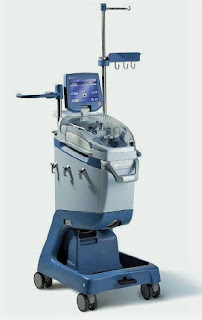Angioneurotic Edema
-A general term applied to the development of acute edema in the subcutaneous or submucous tissues.
-Anesthetic
help may be sought during an attack, when edema of the lips, tongue, or larynx may
cause respiratory problems.
Causes:
-Angioedema may be secondary to the release of histamine, or many other vasoactive substances such as bradykinins, prostaglandins, or leukotrienes.
-It is thought that pediatric and adult angioedemas differ. Children are less likely to require intubation or tracheostomy than adults. Recent work in adults has shown substantial increases in plasma bradykinin during attacks of hereditary, acquired, or captopril-induced angioedema.
-The development of edema may be:
1. Part of a general anaphylactoid
or anaphylactic reaction to a drug, bite, sting, or the ingestion of a substance.
2. A manifestation of hereditary
angioneurotic edema, a condition caused by a deficiency of C1 esterase
inhibitor.
3. A result of an acquired form of
C1 esterase inhibitor deficiency which usually occurs in association with a
B-lymphocyte malignancy.
4. A known side effect of a drug. Recently, there have been several cases of angioedema reported, usually involving the tongue, floor of the mouth, epiglottis, and aryepiglottic folds, secondary to treatment with ACE inhibitors. Most occur in the first week of treatment but may be delayed for up to a year. Can be associated with elevated serum bradykinin levels.
Presentation:
1. There may be a history of a
predisposing factor. This can be ingestion of food or a drug, an infection,
bite or sting, a family history of angioedema, or a B-lymphocytic malignancy.
2. Edema of subcutaneous tissue may
occur alone or be accompanied by hypotension.
3. Patients taking ACE inhibitors
have developed problems in the perioperative period. Angioedema of the tongue
occurred 15 min after tracheal tube removal.
4. A patient with acquired C1
esterase inhibitor deficiency undergoing cardiopulmonary bypass had massive
activation of the common pathway, coagulopathy, pulmonary edema, and circulatory
collapse.
Management:
1. Assessment of severity of airway
obstruction.
2. If the angioedema is part of an anaphylactic or anaphylactoid reaction:
a) Give epinephrine (adrenaline) IV
or IM, 0.1–0.5 mg depending on the severity.
b) If the condition is severe and
involves the glottis, an airway should be established, either by tracheal
intubation, cricothyroidotomy, or tracheostomy.
c) Second-line treatment includes IV
fluids, chlorpheniramine IV 10–20 mg, and steroids.
3. Hereditary angioneurotic edema,
or acquired C1 esterase inhibitor deficiency. These do not respond to
epinephrine (adrenaline) or antihistamines, but to replacement of the deficient
inhibitor by either:
a) An infusion of fresh frozen
plasma.
b) Purified C1 esterase inhibitor
concentrate.
Read more ☛ Acquired C1 Esterase Inhibitor Deficiency

































